The current edition of Lasang Pinoy (hosted by Minette) for the month of November is all to do with 'soul' food ... OR ... food we have during All Soul's Day (2nd Nov). Well, I'll stretch that out a little bit and include Undras or All Saints' Day (1st Nov) which is the day before. Since my soul food are all pretty ordinary, I thought of blogging about what our family had to prepare every year on that Philippine holiday.
As a backgrounder, Filipinos do not traditionally celebrate the evening of 31st October which is Halloween - that came with the onslaught of the American TV/Hollywood influence only in the latter years. What get us all so busy in preparing for a 'celebration' (if you can call it that) is the paying of respects to our dead family members on the 1st day of November. Everyone treks to the family plots in cemeteries up and down the country, light up candles and offer prayers. But you know us Pinoys, no matter what the occasion we never forget to stuff ourselves silly and generally have a party. So even though it should be a solemn event, people take a lot of food and stereo hi-fis in the cemetery and have a picnic. For more info on this click here and here.
In our family, the few days before Undras is a flurry of activities for everyone. Besides the cleaning of the house and yard, cleaning and repainting of the nitcho (tomb) of our dear departed relatives, my maternal side's family in Cavite always make Suman Sa Lihiya every year without fail. Since I practically grew up there, from a very early age I was sat down on a bangko (stool) and helped in this activity that involved the whole family. Invariably, it was my late Lolo Apeng (maternal grandfather) who orchestrated everything. He was a stickler for details and a perfectionist. Usually, he's the one who's at the end of the assembly line - tying together the suman at the same time acting as a QA - scrutinizing everything in our handiwork. And woe is to anyone who did not measure up, for sure he/she will get a yelling right there and then.
Suman, (in case you don't know) is a Filipino snack usually made of sticky rice or some other root crops such as cassava and tightly wrapped in leaves (usually banana). In fact, the word suman can also mean something or someone encased in something very tight. 'Para kang suman sa suot mo.' 'You look like a suman with what you're wearing.' Meaning the clothes are very tight. ;)
I surely miss those times in Cavite during Undras, besides the food, I miss the trek me and my cousins make to the cemetery to visit our great grandparents' tombs. Unlike other families, we were not allowed to bring along any food though that did not prevent us from having streetfood galore from the numerous vendors around. Nor were we allowed any radio/stereo sets so all we have to pre-occupy ourselves were the candles and we had great time trying to outdo one another in collecting the dripping wax and forming the biggest candlewax ball of all (which my aunts later make into floorwax). Only downside of this was regularly losing almost all of my fringe (bangs) from those pesky candles. ;)
Since I was only little then, I only get to do the darang sa apoy (singeing/scorching) of the banana leaves and its preparations. That was my territory I was the banana leaf queen. My grandmother said that the best banana leaf for making suman is from the butuhan variety. They are thicker, less brittle and more flexible thus less likely to fall apart although I can't say much with its fruit whose name is so appropriate.
To be honest, this is actually the first time I've done this suman from start to finish. Although I watched my relatives so many times doing this, I have yet to actually wrap and tie one until today. As I was struggling to put my gingerly tied sumans in the pot, I suddenly realised the reason for my Lolo Apeng's suman boiler's shape. For decades I wondered how come the big 'pot' (I think he had it made to order) he used was shaped like a big suitcase. It was rectangular and even had a nice fitting lid. Well of course the suman when tied and assembled is rectangular in shape - rather like a brick. So his pot, shaped as it is, perfectly maximizes space in cooking the suman. How ingenious!
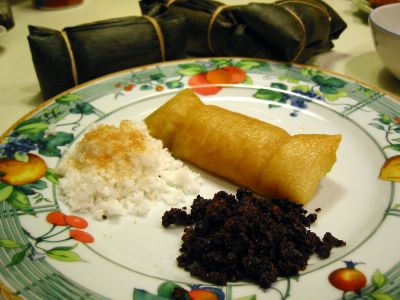
For this dish (snack?), I presented it with the different dips we use in eating it. Since the Suman sa Lihiya is very bland with just a hint taste of lye water and the banana leaves, you have to have at least some sugar to dip it in. For me the best is still the grated coconut with brown sugar. We also use latik and in my eagerness to perfectly capture a picture, I promptly burned the latik (yikes!) though it's still edible (in a dark bitter way). When we get sick and tired of eating it as it is, we pan-fry it for breakfast, slather on some butter and dip in the same suspects. Though in the mornings we're too lazy to get anything else so it would usually be just sugar.
Speaking of pictures, I got a bit trigger happy so apologies if you get bored with too many images of banana leaves and sumans.
I know most of you know this but this one is for my kids - below are pictures showing how the topside and underside of the banana leaf looks like:
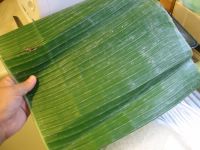
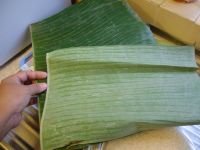
banana leaf topside                           banana leaf underside
*To prepare the banana leaf:   Singe or scorch the leaves on an open flame or hot burner with the underside DOWN. You are in effect 'cooking' the underside. This only takes a few seconds, once you see the leaves changing opacity or colour then move it to other areas that's not yet singed. Turn the leaf over and very briefly heat the top side all over. DO NOT burn the leaves. This exercise will make the leaves less brittle and more flexible.
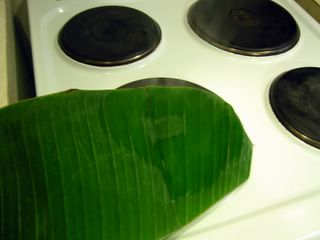
After this when it has cooled down, wipe down both sides of the leaf with a clean cloth. Cut off the central ribs of the leaves.
Suman Sa Lihiya
1 kg malagkit na bigas (glutinous rice)
2 tsp lihiya (lye water)
prepared banana leaves
thin cotton strings
*Condiments:
grated coconut
brown sugar
Latik
- Cut or separate banana leaves into two sizes (all approximates) - one 9 x 11-inch size and the other 5 x 5-inches.
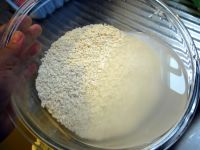 Soak the glutinous rice in water for about 1-2 hours.
Soak the glutinous rice in water for about 1-2 hours.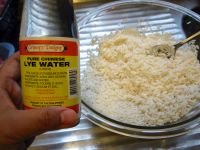 Drain and mix in the lye water. It should turn yellowish (this would depend on the strength of the lye water), if not add more lye water a little at a time until it turns yellowish. Mix well.
Drain and mix in the lye water. It should turn yellowish (this would depend on the strength of the lye water), if not add more lye water a little at a time until it turns yellowish. Mix well.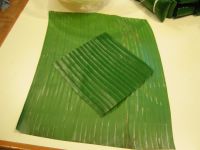 Put the big sized leaf lengthwise on a working surface - topside down. Then put the smaller one on top of it - topside up and aligned either same as the bigger piece OR positioned with the one of the corners pointing to the narrow side of the bigger piece.
Put the big sized leaf lengthwise on a working surface - topside down. Then put the smaller one on top of it - topside up and aligned either same as the bigger piece OR positioned with the one of the corners pointing to the narrow side of the bigger piece.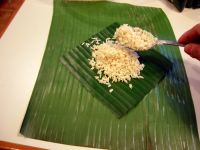 Place about 3 tablespoonfuls of the glutinous rice mixture on the smaller piece of leaf.
Place about 3 tablespoonfuls of the glutinous rice mixture on the smaller piece of leaf.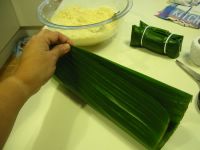 Grab the 2 long sides of the bigger piece and bring them together. Fold or roll that side to enclose the rice (about 3 half-inch folds). It is now long and narrow shaped.
Grab the 2 long sides of the bigger piece and bring them together. Fold or roll that side to enclose the rice (about 3 half-inch folds). It is now long and narrow shaped.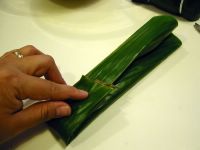 Fold about the lower 1/4 of the parcel towards the center.
Fold about the lower 1/4 of the parcel towards the center.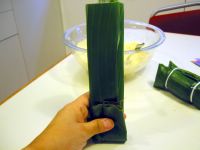 While firmly holding the folded end of the parcel, put it upright and tap it on the table to pack in the rice and if need be add more rice through the open end.
While firmly holding the folded end of the parcel, put it upright and tap it on the table to pack in the rice and if need be add more rice through the open end.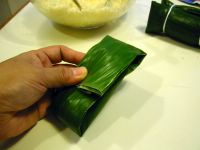 Fold the top end towards the center. You should have a parcel about 5 x 2-inches in size.
Fold the top end towards the center. You should have a parcel about 5 x 2-inches in size. Make another suman parcel of roughly the same size.
Make another suman parcel of roughly the same size.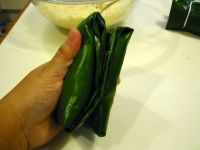 Pair these two parcels with the folded sides facing together.
Pair these two parcels with the folded sides facing together.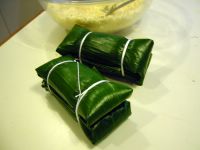 Using thin cotton strings, tie the two ends together tightly.
Using thin cotton strings, tie the two ends together tightly.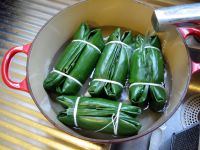 Place the assembled pieces in a big pot and add enough water to cover the suman.
Place the assembled pieces in a big pot and add enough water to cover the suman.- Bring to boil and bring down heat to low and simmer for about 1 1/2 hours.
- Serve warm or cold with grated coconut and sugar.

* For the Latik:
- Add 2 Tbsp sugar and pinch of salt to a 400 ml can of coconut milk in a wok or pan (preferably non-stick). Stir until sugar and salt is dissolved.
- Bring to boil then lower heat and simmer until it renders oil and sediments (the latik) start to stick to the bottom.
- At this point watch it very closely and stir it frequently (it burns easily) and fry the sediments until golden brown.
- Remove from oil with slotted spoon. Serve with the suman.
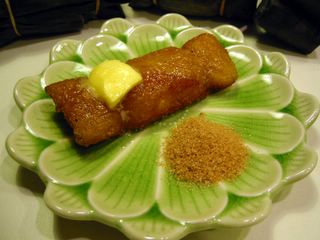
Sometimes when we get tired of eating it the usual way, we pan-fry it for breakfast and have it with butter and then dipped it in grated coconut with sugar or just plain sugar.
Lasang Pinoy 4

6 comments:
Hello, kabayan. Thanks for sharing this recipe. I pointed to this recipe over at visitpinas.com
Thanks Fred. :) I love your visitPinas website!
the best suman sa lihiya recipe! i never thought that this is so simple and easy to make! thank you so much!
Hi Ms Celia. I've been looking at your site for almost 2 years now and I am very thankful for what you've been doing. I has kept me sane for the times I wanted to eat filipino food but did not know how to make it. You are a blessing. Thank you very much.
Hi, thanks for your recipe. I learned how to make Suman sa lihiya and even make some improvements over it! I hope you don't mind if i link this article to my blog.
Wow ang sarap pero mukang mahirap lutuin.
I will ask my wife to follow your recipe.
Post a Comment